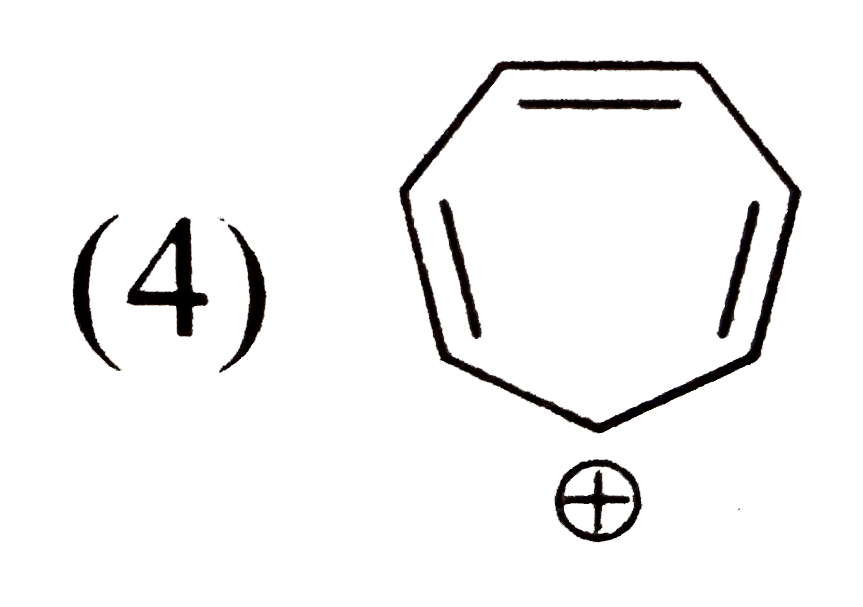Which of the following will show aromatic behaviour ?




The correct Answer is:b
To determine which of the given compounds shows aromatic behavior, we need to apply Huckel's rule and the criteria for aromaticity. Here’s a step-by-step solution:
Step 1: Understand the Criteria for Aromaticity
A compound is considered aromatic if it meets the following criteria:
1. Cyclic Structure: The compound must be a ring.
2. Planarity: The compound must be planar, allowing for overlapping p-orbitals.
3. Conjugation: There must be a complete cyclic conjugation of pi electrons.
4. Huckel's Rule: The compound must have (4n + 2) pi electrons, where n is a non-negative integer (0, 1, 2, ...).
Step 2: Analyze Each Compound
Let’s analyze the compounds one by one:
Compound 1:
- Cyclic: Yes, it is cyclic.
- Planar: Check if all atoms are sp2 hybridized.
- Conjugation: Look for alternating double bonds.
- Pi Electrons: Count the pi electrons and check if they fit Huckel's rule.
Conclusion: This compound does not have complete cyclic conjugation, so it is not aromatic.
Compound 2:
- Cyclic: Yes, it is a benzene ring.
- Planar: All carbon atoms in benzene are sp2 hybridized.
- Conjugation: Benzene has complete conjugation with alternating double bonds.
- Pi Electrons: Benzene has 6 pi electrons (C6H6), which fits Huckel's rule (4n + 2, where n=1).
Conclusion: This compound is aromatic.
Compound 3:
- Cyclic: Yes, it is cyclic.
- Planar: Check the hybridization of the atoms.
- Conjugation: Look for alternating double bonds.
- Pi Electrons: Count the pi electrons.
Conclusion: If all atoms are sp3 hybridized and there are no pi bonds, this compound is not aromatic.
Compound 4:
- Cyclic: Yes, it is cyclic.
- Planar: Check the hybridization.
- Conjugation: Look for pi bonds.
- Pi Electrons: Count the pi electrons.
Conclusion: If it has 4 pi electrons and does not fit Huckel's rule, it is not aromatic.
Final Conclusion
Among the given compounds, only Compound 2 (benzene) shows aromatic behavior.
A compound is considered aromatic if it meets the following criteria:
1. Cyclic Structure: The compound must be a ring.
2. Planarity: The compound must be planar, allowing for overlapping p-orbitals.
3. Conjugation: There must be a complete cyclic conjugation of pi electrons.
4. Huckel's Rule: The compound must have (4n + 2) pi electrons, where n is a non-negative integer (0, 1, 2, ...).
Let’s analyze the compounds one by one:
- Cyclic: Yes, it is cyclic.
- Planar: Check if all atoms are sp2 hybridized.
- Conjugation: Look for alternating double bonds.
- Pi Electrons: Count the pi electrons and check if they fit Huckel's rule.
- Cyclic: Yes, it is a benzene ring.
- Planar: All carbon atoms in benzene are sp2 hybridized.
- Conjugation: Benzene has complete conjugation with alternating double bonds.
- Pi Electrons: Benzene has 6 pi electrons (C6H6), which fits Huckel's rule (4n + 2, where n=1).
- Cyclic: Yes, it is cyclic.
- Planar: Check the hybridization of the atoms.
- Conjugation: Look for alternating double bonds.
- Pi Electrons: Count the pi electrons.
- Cyclic: Yes, it is cyclic.
- Planar: Check the hybridization.
- Conjugation: Look for pi bonds.
- Pi Electrons: Count the pi electrons.
Among the given compounds, only Compound 2 (benzene) shows aromatic behavior.
Topper's Solved these Questions
- ORGANIC CHEMISTRY SOME BASIC PRINCIPLES AND TECHNIQUES Book:DISHA PUBLICATIONChapter:ORGANIC CHEMISTRY SOME BASIC PRINCIPLES AND TECHNIQUES Exercise:Exercise - 2 : Concept Applicator
Explore 30 Videos
- ORGANIC CHEMISTRY SOME BASIC PRINCIPLES AND TECHNIQUES Book:DISHA PUBLICATIONChapter:ORGANIC CHEMISTRY SOME BASIC PRINCIPLES AND TECHNIQUES Exercise:Exercise - 1 : Concept Builder (Topicwise) TOPIC 2 : isomerism in Organic Compounds )
Explore 17 Videos
- JEE MAIN 2019Book:DISHA PUBLICATIONChapter:JEE MAIN 2019Exercise:MCQs
Explore 30 Videos
- POLYMERS Book:DISHA PUBLICATIONChapter:POLYMERS Exercise:EXERCISE -2 : CONCEPT APPLICATOR
Explore 30 Videos
Similar Questions
Knowledge Check
Which of the following is not aromatic?
A B
B C
C D
D
Which of the following is not aromatic ?
ABenzeneBCyclooctatetraenyl dianionCTropylium cationDCyclopentadienyl cationWhich of the following is not aromatic?
Acyclopentadienyl cationBcyclopropenyl cationCTropylium cationDCyclopentadienyl anion

